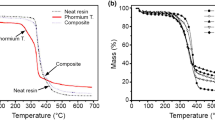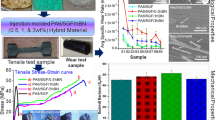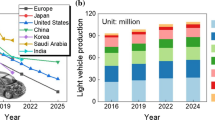Abstract
In this paper, the comparison of fatigue life between C/SiC and SiC/SiC ceramic-matrix composites (CMCs) at room and elevated temperatures has been investigated. An effective coefficient of the fiber volume fraction along the loading direction (ECFL) was introduced to describe the fiber architecture of preforms. Under cyclic fatigue loading, the fibers broken fraction was determined by combining the interface wear model and fibers statistical failure model at room temperature, and interface/fibers oxidation model, interface wear model and fibers statistical failure model at elevated temperatures in the oxidative environments. When the broken fibers fraction approaches to the critical value, the composites fatigue fracture. The fatigue life S–N curves and fatigue limits of cross-ply, 2D and 3D C/SiC and SiC/SiC composites at room temperature, 550 °C in air, 750 °C in dry and humid condition, 800 °C in air, 1000 °C in argon and air, 1100 °C, 1300 °C and 1500 °C in vacuum, have been predicted. At room temperature, the fatigue limit of 2D C/SiC composite with ECFL of 20 % lies between 0.78 and 0.8 tensile strength; and the fatigue limit of 2D SiC/SiC composite with ECFL of 20 % lies between 0.75 and 0.85 tensile strength. The fatigue limit of 2D C/SiC composite increases to 0.83 tensile strength with ECFL increasing from 20 to 22.5 %, and the fatigue limit of 3D C/SiC composite is 0.85 tensile strength with ECFL of 37 %. The fatigue performance of 2D SiC/SiC composite is better than that of 2D C/SiC composite at elevated temperatures in oxidative environment.



























Similar content being viewed by others
References
Naslain, R.: Design, preparation and properties of non-oxide CMCs for application in engines and nuclear reactors: an overview. Compos. Sci. Technol. 64, 155–170 (2004). doi:10.1016/S0266-3538(03)00230-6
Schmidt, S., Beyer, S., Knabe, H., Immich, H., Meistring, R., Gessler, A.: Advanced ceramic matrix composite materials for current and future propulsion system applications. Acta Astronaut. 55, 409–420 (2004). doi:10.1016/j.actaastro.2004.05.052
DiCarlo, J.A., Van Roode, M.: Ceramic composite development for gas turbine hot section components. Proc. ASME Turbo Expo Power Land Sea Air 2, 221–231 (2006)
Bertrand, D.J., Sabelkin, V., Zawada, L., Mall, S.: Fatigue behavior of sylramic-iBN/BN/CVI SiC ceramic matrix composite in combustion environment. J. Mater. Sci. 50, 7437–7447 (2015). doi:10.1007/s10853-015-9302-8
Li, L.B.: Fatigue hysteresis behavior of cross-ply C/SiC ceramic matrix composites at room and elevated temperatures. Mater. Sci. Eng. A 586, 160–170 (2013). doi:10.1016/j.msea.2013.08.017
Li, L.B.: Fatigue damage models and life prediction of long-fiber-reinforced ceramic matrix composites. PhD Thesis, Nanjing University of Aeronautics and Astronautics, Nanjing, China, (2010).
Shuler, S.F., Holmes, J.W., Wu, X.: Influence of loading frequency on the room-temperature fatigue of a carbon-fiber/SiC-matrix composite. J. Am. Ceram. Soc. 76, 2327–2336 (1993). doi:10.1111/j.1151-2916.1993.tb07772.x
Lu, M.P., Tong, X.Y., Ren, S.H., Yao, L.J.: Fatigue behavior and life prediction of 2D C/SiC under room temperature. Adv. Aeronaut Sci. Eng. 5, 104–108 (2014) (in Chinese)
Min, J.B., Xue, D., Shi, Y.: Micromechanics modeling for fatigue damage analysis designed for fabric reinforced ceramic matrix composites. Compos. Struct. 111, 213–223 (2014). doi:10.1016/j.compstruct.2013.12.025
Mall, S., Engesser, J.M.: Effects of frequency on fatigue behavior of CVI C/SiC at elevated temperature. Compos. Sci. Technol. 66, 863–874 (2006). doi:10.1016/j.compscitech.2005.06.020
Cheng, Q.Y., Tong, X.Y., Zheng, X., Zhou, J., Yao, L.J., Li, B.: Experimental investigation on the fatigue characteristics about high temperature of plain-woven C/SiC composite. J. Mech. Strength 32, 819–823 (2010) (in Chinese)
Du, S.M., Qiao, S.R., Ji, G.C., Han, D.: Tension-tension fatigue behavior of 3D-C/SiC composite at room temperature and 1300 °C. Mater. Eng. 9, 22–25 (2002) (in Chinese)
Du, S.M., Qiao, S.R.: Tension-tension fatigue behavior of 3D-C/SiC composite at 1500 °C. Mater. Eng. 5, 34–37 (2011) (in Chinese)
Reynaud, P.: Cyclic fatigue of ceramic-matrix composites at ambient and elevated temperatures. Compos. Sci. Technol. 56, 809–814 (1996). doi:10.1016/0266-3538(96)00025-5
Mall, S.: Effects of moisture on fatigue behavior of SiC/SiC composite at elevated temperature. Mater. Sci. Eng. A 412, 165–170 (2005). doi:10.1016/j.msea.2005.08.040
Mizuno, M., Zhu, S.J., Nagano, Y., Sakaida, Y., Kagawa, Y., Watanabe, M.: Cyclic-fatigue behavior of SiC/SiC composites at room and high temperatures. J. Am. Ceram. Soc. 79, 3065–3077 (1996). doi:10.1111/j.1151-2916.1996.tb08078.x
Michael, W.K.: Fatigue behavior of a SiC/SiC composite at 1000 °C in air and steam. AFIT/GAE/ENY/10-D01 (2010).
Jacob, D.: Fatigue behavior of an advanced SiC/SiC composite with an oxidation inhibited matrix at 1200 °C in air and in steam. AFIT/GEA/ENY/10-M07 (2010).
Zhu, S.J., Mizuno, M., Nagano, Y., Cao, J.W., Kagawa, Y., Kaya, H.: Creep and fatigue behavior in an enhanced SiC/SiC composite at high temperature. J. Am. Ceram. Soc. 81, 2269–2277 (1998). doi:10.1111/j.1151-2916.1998.tb02621.x
Ruggles-Wrenn, M.B., Sharma, V.: Effects of steam environment on fatigue behavior of two SiC/[SiC+Si3N4] ceramic composites at 1300 °C. Appl. Compos. Mater. 18, 385–396 (2011). doi:10.1007/s10443-010-9163-x
Shi, D.Q., Jing, X., Yang, X.G.: Low cycle fatigue behavior of a 3D braided KD-I fiber reinforced ceramic matrix composite for coated and uncoated specimens at 1100 °C and 1300 °C. Mater. Sci. Eng. A 631, 38–44 (2015). doi:10.1016/j.msea.2015.01.078
Li, L.B.: Fatigue hysteresis of carbon fiber-reinforced ceramic-matrix composites at room and elevated temperatures. Appl. Compos. Mater. 23, 1–27 (2016). doi:10.1007/s10443-015-9448-1
Li, L.B.: Modeling fatigue hysteresis behavior of unidirectional C/SiC ceramic-matrix composite. Compos. Part B 66, 466–474 (2014). doi:10.1016/j.compositesb.2014.06.014
Li, L.B.: Fatigue life prediction of carbon fiber-reinforced ceramic-matrix composites at room and elevated temperatures. Part I: Experimental analysis. Appl. Compos. Mater. 23, 101–117 (2016). doi:10.1007/s10443-015-9446-3
Li, L.B.: Fatigue life prediction of carbon fiber-reinforced ceramic-matrix composites at room and elevated temperatures. Part II: Experimental comparisons. Appl. Compos. Mater. 22, 961–972 (2015). doi:10.1007/s10443-015-9445-4
Curtin, W.A., Ahn, B.K., Takeda, N.: Modeling brittle and tough stress–strain behavior in unidirectional ceramic matrix composites. Acta Mater. 46, 3409–3420 (1998). doi:10.1016/S1359-6454(98)00041-X
Evans, A.G., Zok, F.W., McMeeking, R.M.: Fatigue of ceramic matrix composites. Acta Metall. Mater. 43, 859–875 (1995). doi:10.1016/0956-7151(94)00304-Z
Lee, S.S., Stinchcomb, W.W.: Damage mechanisms of cross-ply Nicalon/CAS-II laminate under cyclic tension. Ceram. Eng. Sci. Proc. 15, 40–48 (1994). doi:10.1002/9780470314500.ch5
Lara-Curzio, E.: Analysis of oxidation-assisted stress-rupture of continuous fiber-reinforced ceramic matrix composites at intermediate temperatures. Compos. Part A 30, 549–554 (1999). doi:10.1016/S1359-835X(98)00148-1
Casas, L., Martinez-Esnaola, J.M.: Modelling the effect of oxidation on the creep behavior of fiber-reinforced ceramic matrix composites. Acta Mater. 51, 3745–3757 (2003). doi:10.1016/S1359-6454(03)00189-7
Acknowledgments
The author thanks the Science and Technology Department of Jiangsu Province for the funding that made this research study possible
Author information
Authors and Affiliations
Corresponding author
Ethics declarations
Funding
This study has received the support from the Science and Technology Department of Jiangsu Province through the Natural Science Foundation of Jiangsu Province (Grant No. BK20140813), and the Fundamental Research Funds for the Central Universities (Grant No. NS2016070).
Conflict of Interest
The author declares that he has no conflict of interest.
Rights and permissions
About this article
Cite this article
Longbiao, L. Comparison of Fatigue Life Between C/SiC and SiC/SiC Ceramic-Matrix Composites at Room and Elevated Temperatures. Appl Compos Mater 23, 913–952 (2016). https://doi.org/10.1007/s10443-016-9492-5
Received:
Accepted:
Published:
Issue Date:
DOI: https://doi.org/10.1007/s10443-016-9492-5




